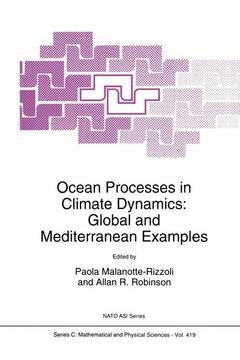Ocean Processes in Climate Dynamics, 1994 Global and Mediterranean Examples Nato Science Series C: Series, Vol. 419
Langue : Anglais
Coordonnateurs : Malanotte-Rizzoli P.M., Robinson Allan R.

One of the most crucial but still very poorly understood topics of oceanographic science is the role of ocean processes in contributing to the dynamics of climate and global change. This book presents a series of high level lectures on the major categories of ocean/atmosphere processes. Three of these major issues are the focus of the lectures: (1) air--sea interaction processes; (2) water mass formation, dispersion and mixing; (3) general circulation, with specific emphasis on the thermohaline component. Global examples in the world ocean are provided and discussed in the lectures. In parallel, the Mediterranean Sea is a laboratory basin in providing analogues of the above global processes relevant to climate dynamics. They include the Mediterranean thermohaline circulation with its own `conveyor belt'; intermediate and deep water mass formation and transformations, dispersion and mixing. No other book in the field provides a review of fundamental lectures on these processes, coupled with global examples and their Mediterranean analogues.
Air-Sea Exchanges and Meridional Fluxe.- 1. Air-sea exchanges.- 2. Meridional heat transport.- 3. Conclusion.- Lagrangian and Eulerian Measurements of Ocean Transport Processe.- 1. Introduction.- 2. Eulerian and Lagrangian frameworks.- 3. Transport measures from current followers.- 4. Ocean measurements of lateral transport.- 5. Diapycnal fluxes.- Dispersion and Mixing in the Ocea.- 1. Introduction.- 2. Inference.- 3. Direct measurement.- 4. Indirect measurements.- 5. Processes.- 6. Conclusions.- 7. Discussion.- Ocean Models in Climate Problem.- 1. Introduction.- 2. Feedbacks affecting the thermohaline circulation.- 3. Large-scale air-sea heat exchanges.- 4. Interaction of the hydrological cycle with the thermohaline circulation.- 5. Numerical models of the thermohaline circulation.- 6. Summary and outlook: towards coupled process models.- Sensitivity Studies on the Role of the Ocean in Climate Chang.- 1. Introduction — CME results on thermohaline overturning.- 2. The surface heat and fresh water flux parameterizations.- 3. A basic experiment.- 4. Sensitivity experiments.- 5. Multiple stable states.- 6. Open boundary conditions.- 7. Discussion.- Modeling the Wind and Thermohaline Circulation in the North Atlantic Ocea.- 1. Introduction — the Community Modeling Effort.- 2. Improving surface boundary conditions.- 3. Open boundary conditions for the CME model.- 4. Internal parameterizations for the CME model.- 5. Discussion.- Studying Thermohaline Circulation in the Ocean by Means of Transient Tracer Dat.- 1. Introduction.- 2. Tracer features and geochemistry.- 3. Information from oceanic tracer distribution.- 4. Tracer evaluation by means of ocean circulation models.- 5. Conclusions.- Laboratory and Numerical Experiments in Oceanic Convectio.- 1. Introduction.- 2. Theinfluence of the Earth’s rotation on the convective process.- 3. A laboratory analogue of a convecting chimney.- 4. Scaling ideas.- 5. Numerical illustrations.- 6. Summary and discussion.- Open Ocean Deep Convection, Mediterranean and Greenland Sea.- 1. Introduction.- 2. The Gulf of Lions, Northwestern Mediterranean.- 3. Greenland Sea convection and the role of ice.- 4. Summary and conclusions.- The Mediterranean Sea as a Climate Test Basi.- 1. Introduction.- 2. Mean heat and water budgets of the Mediterranean.- 3. Variability.- 4. Buoyancy flux.- 5. Models.- 6. Discussion.- The Mediterranean Sea, a Test Area for Marine and Climatic Interaction.- 1. Yearly budgets.- 2. Spatial variability of heat and water transfers.- 3. Recent hydrological changes.- 4. Mediterranean sapropel formation, a change in deep-water formations.- 5. Conclusions.- The Physical and Dynamical Oceanography of the Mediterranean Se.- 1. Introduction.- 2. Air-sea interactions and straits exchanges.- 3. Watermass formation, dispersion and transformation.- 4. Circulation and its variabilities.- 5. Modelling.- 6. General circulation summary.- 7. Historical perspective and climatological analysis.- 8. Conclusions and summary.- Modeling the General Circulation of the Mediterranea.- 1. Introduction.- 2. Prognostic models.- 3. Inverse models.- 4. Conclusions.- Data Assimilation: Fundamentals, Global and Mediterranean Example.- 1. Introduction.- 2. Assimilation method: fundamentals.- 3. Global and Mediterranean examples.- 4. Conclusions.- Deep-Water in the Western Mediterranean Sea, Yearly Climatic Signature and Enigmatic Spreadin.- 1. Introduction.- 2. Hydrological data.- 3. Climatic driving-force.- 4. The spreading of the newly-formed dense water.- 5. Homogenization of deep water, the Earth heat floweffect.- 6. Conclusion.- A Tracer Study of the Thermohaline Circulation of the Eastern Mediterranea.- 1. Introduction.- 2. Outline of thermohaline circulation.- 3. Tracer observations, tracer geochemistry and qualitative oceanographic findings.- 4. System-analysis-model evaluation.- 5. General circulation model treatment.- 6. Discussion and conclusions.- Dynamical Studies of the Eastern Mediterranean Circulatio.- 1. Introduction.- 2. Features and structures of the general circulation.- 3. Basin and subbasin scale dynamical processes.- 4. Mesoscale dynamical processes.- 5. Conclusions.- Models and Data: A Synergetic Approach in the Western Mediterranean Se.- 1. Introduction.- 2. The structure of the mesoscale algerian eddies.- 3. The circulation of LIW.- 4. The WMDW circulation.- 5. Conclusion.
Date de parution : 11-2012
Ouvrage de 437 p.
16x24 cm
Thèmes d’Ocean Processes in Climate Dynamics :
Mots-clés :
© 2024 LAVOISIER S.A.S.



